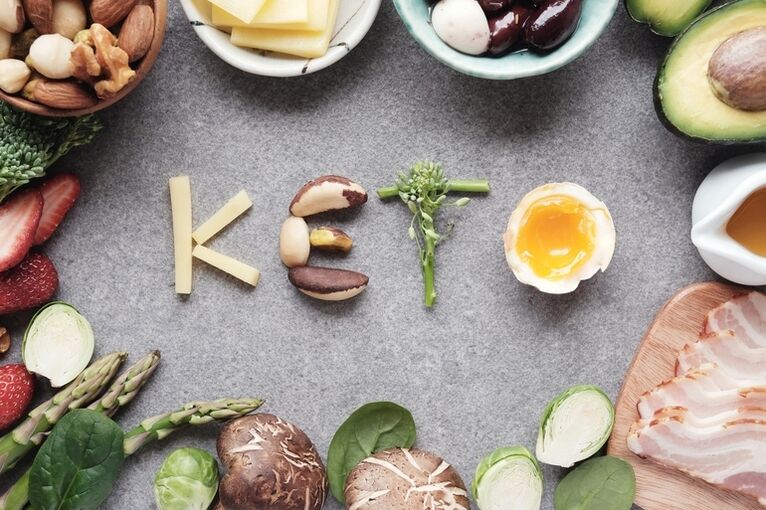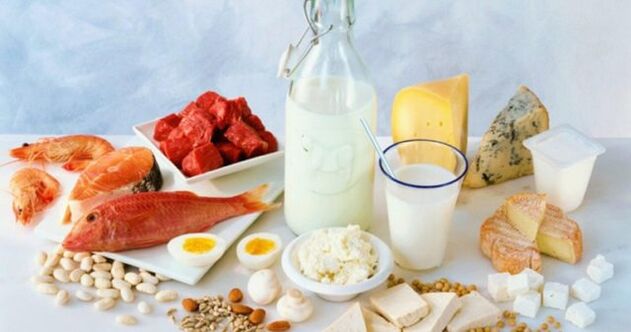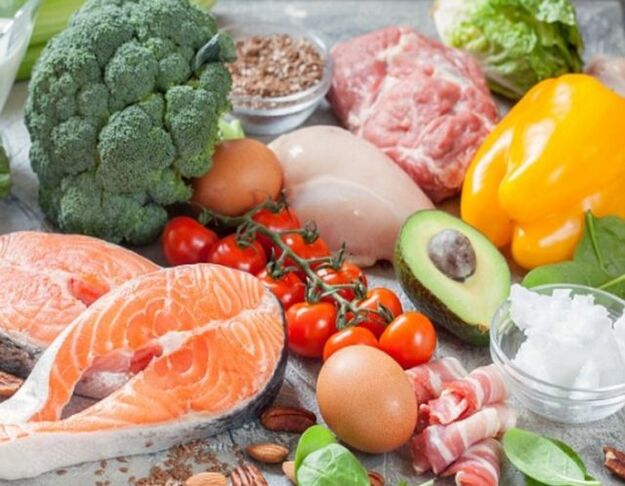The ketone diet was developed in 1921 to treat epilepsy. Later, bodybuilders started using it for muscle relief. The use of fat as a fuel is only possible with reduced amounts of carbohydrates and a small percentage of protein - these are the principles of the keto diet.
What is a keto diet?
A ketogen, ketone, or keto diet (keto) is a diet low in carbohydrates, moderate protein, and high in fat.
Consumption of carbohydrates produces glucose and insulin. Glucose is most easily consumed by the body as a fuel. Insulin is needed to deliver glucose to cells. In these cases, the fats do not require and only accumulate. However, when the amount of carbohydrates decreases, the body is forced into a state of ketosis - a natural process where the body begins to use fats as fuel.

In the absence of glucose in the liver, ketone bodies are formed from free fatty acids. Ketones or ketone bodies are molecules that carry energy to function in the body. The goal of keto is to become such a state.
There are 4 types, 3 of which are used by athletes and one by all other keto fans:
- Standard: basic keto ratio% BJU - 20: 75: 5.
- Purposeful: the amount of carbohydrates increases during exercise.
- Cyclic: Higher carbohydrate intake, such as on weekends.
- High protein content: instead of a decrease, the protein increases to about 35%. The overall ratio of BJU is 35: 60 to 5.
Approved products
The following products are available:
- Any meat: veal, pork, poultry, etc. Do not remove fat from meat and chicken.
- In chickens, the thighs and legs are preferred.
- Fish and seafood: any, but fatty fish is better - salmon, mackerel, sardines, anchovies, salmon and herring, shrimp and squid.
- Eggs: in any form.
- Natural fats: lard and lard for frying ghee, salted butter, coconut oil, avocado, flaxseed and olive oil for salads.
- Nightshade vegetables: kale, zucchini, eggplant, asparagus, olives, spinach, lettuce, green vegetables and leafy greens.
- Mushrooms: any.
- Only high-fat dairy products: whole-fat milk (more than 3%), cream (20-40%), sour cream 25%, cottage cheese, Greek yogurt, fatty hard cheeses.
- Oil nuts and seeds: macadamia nuts, cashew nuts, walnuts, sunflower seeds, pumpkin seeds, etc.
- Berries: in small quantities - raspberries, blackberries, blueberries.

Occasionally allowed:
- Alcohol: dry wines, unsweetened spirits (gin, rum, whiskey, vodka), unsweetened cocktails.
- Dark chocolate: very moderate, with more than 70% cocoa.
- Water, cream coffee, tea and herbal teas to taste.
- Chicken broth or broth with at least 1 g of sodium. When carbohydrates are reduced, glycogen is actively consumed. 1 g requires 3 g of water. This also eliminates the sodium that the body needs. According to nutrition experts, chicken broth is essential in this diet because it provides sodium to the body.
Prohibited products:
- Sweets - sugar, candies, cakes, ice cream, honey, maple syrup, agave.
- Sugar drinks - soft drinks, juices, coffee with milk, beer, etc.
- Cereals, cereals and rice are high in carbohydrates.
- Sweet fruits - bananas, apples, grapes, oranges, pears, mangoes, pineapples, etc.
- Beans are rich in carbohydrates.
- Potatoes are rich in starch.
- Shop sauces - ketchup and barbecue sauce.
- Margarine - a complete lack of benefit.
- Artificial trans fats - sometimes worsen health.
Important! The more restrictions (less than 15 grams of carbohydrate per day), the faster a person gets into a state of ketosis.
Keto diet: menu
| Breakfast | Lunch | Dinner | afternoon tea | Dinner | |
|---|---|---|---|---|---|
| Monday | fried eggs with asparagus and bacon and coffee cream | high fat cottage cheese; salad and chocolate | chicken breast fried in coconut oil, fried mushrooms, spinach, avocado and lime juice | boiled beef; some nuts and rosehip infusion | tuna steak in olive oil with chili and garlic, roasted broccoli and bean sprouts, grilled tomatoes |
| Tuesday | coffee with butter or ghee, 3 boiled eggs | greasy cottage cheese | beef steak, tomatoes, fried bacon in lettuce leaves; fish soup with meatballs | cheese | low carb chicken grandmasala (spice mix); salmon with toast and cheese, tea |
| Wednesday | omelette with mushrooms and bell peppers in olive oil; cream with cream | cottage cheese | bacon, avocado and feta salads; broth with herbs, chicken slices | 3 egg omelettes; green tea with nuts. | roast pork with mayonnaise and onion; green apple puree |
| Thursday | beef steak, croutons | turkey with green tea. | beef soup with minced meat; meatballs from perch; roasted cabbage and broccoli eggs in the form of a salad, unsweetened compote. | rosehip broth with chicken breast | avocado and shrimp in creamy mayonnaise and chili sauce |
| Friday | Fried bacon and cauliflower with fried eggs | cheese, vegetable salad, dogwood broth | fish soup with meatballs, chicken soup, quince soup. | zucchini slices, vegetable salad | pasta with turkey, tomatoes, mushrooms and parmesan sauce |
| Saturday | cauliflower based pizza | greasy cottage cheese and green tea | beef steak, croutons, coffee with butter | salmon salad with tomatoes and blueberries | low carb beef with chili sauce and garlic |
| Sunday | bacon cakes and salad | 3 hard boiled eggs, biscuits, unsweetened compote | red fish with toast cheese | chicken caesar salad with parmesan cheese | beef pate, kefir |
Who is forbidden from such a diet
Keto diet is contraindicated:
- diabetes
- hypertension;
- hypercholesterolemia;
- renal and gastrointestinal diseases;
- decompensation of cardiac function;
- during pregnancy and lactation.

Benefits and harms of the Keto diet
Benefits of the diet:
- effectively solves the issue of weight loss, muscle mass gain, body drying;
- regulates blood sugar levels;
- Helps treat type 2 diabetes
- improves cognitive abilities;
- normalizes cholesterol and blood pressure;
- cleanses the skin of acne;
- helps reduce the number of anticonvulsants taken in epilepsy;
- useful in Alzheimer's disease and Parkinson's disease;
- financially inexpensive;
- Preparing food is not difficult.
Disadvantages:
- low carb, unbalanced
- they are not shown to everyone;
- reduces work capacity and memory.
Nutrition experts' opinions on the Keto diet
The focus of the keto diet is on protein and fatty foods with extremely low fiber content. It is full of bloating and difficulty in the stomach, constipation. In addition, the intestines are colonized by pathogenic microorganisms, ending in dysbacteriosis. Immunity is reduced. To avoid such problems, the fiber should be consumed at least minimally - cabbage, apples, pickles.
Carbohydrate deficiency is a big minus, and the body can react to it with an inappropriate reaction.
If physical activity exceeds the body's ability, it can cause hypoglycaemia in the form of weakness, pressure drop, dizziness, nausea, until fainting and collapse. To prevent this, it is better to consume juices and semi-sweet fruits during snacks, and when the first signs of hypoglycemia appear, drink tea with honey.

Lack of glucose reduces brain function. Cognitive components - attention, concentration, memory - are particularly affected. After reaching the ketosis phase, they partially recover, but the level still does not reach the previous norm. Therefore, when taking exams, it is better not to use this diet than hard mental work.
A ketogenic diet can lead to kidney stones, dehydration, high blood cholesterol, constipation and gout attacks. Essential minerals and vitamins are lacking with ketones, so taking vitamin complexes is necessary.
Keto, of course, improves the body, dissolves the metabolism and loses weight, but the transition to such a special diet is quite difficult and requires consultation with a doctor. The keto diet is not for everyone. Only a doctor can tell you whether to start a diet after checking your current condition.






























